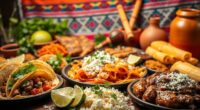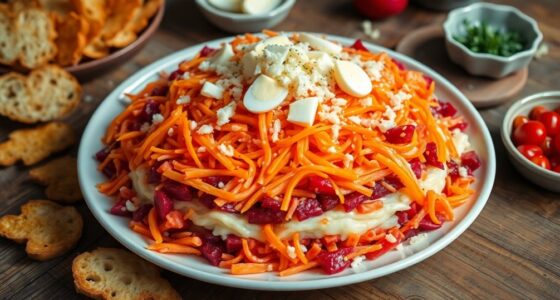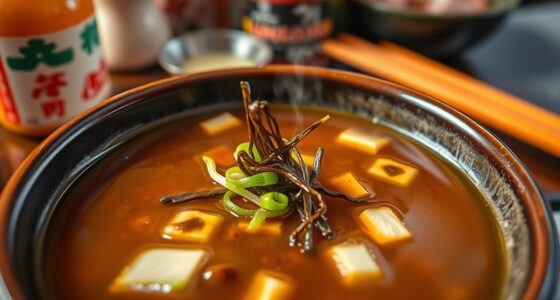Imagine sitting at a vibrant table, surrounded by your loved ones, sharing stories and laughter over a spread of colorful and aromatic dishes. Colombian cuisine is not just food; it’s a celebration of authentic Colombian flavors that brings people together, forming connections and memories. Each bite transports you to the rich landscapes of Colombia, where traditional Colombian dishes reflect a remarkable tapestry of cultures—indigenous, African, and Spanish. This culinary journey promises to awaken your taste buds and introduce you to an array of familiar and exotic flavors that are uniquely Colombian. Prepare to explore the heart of Colombian gastronomy—where every dish tells a story and every ingredient evokes a sense of belonging.
As you delve deeper into the world of Colombian cuisine, you’ll find that it’s a fusion of history and innovation, where time-honored recipes are blended with fresh, local produce. From hearty stews that speak to the soul, to sweet treats that warm your heart, each dish is an invitation to share in Colombia’s vibrant culture. Join us as we explore the top dishes you simply must try, and discover how Colombian cuisine can transform your dining experience into something truly special.
Key Takeaways
- Colombian cuisine is a rich blend of indigenous, African, and Spanish influences.
- Traditional Colombian dishes showcase a variety of ingredients and cooking techniques.
- Each region in Colombia offers unique flavors and cooking styles.
- Meals in Colombia are about sharing, celebrating, and bringing people together.
- Exploring Colombian food opens doors to understanding its vibrant culture.
- From hearty stews to sweet treats, Colombian cuisine is diverse and inviting.
What is Colombian Cuisine?
Colombian cuisine reflects a vibrant mix of flavors shaped by the country’s diverse cultural influences. Each region contributes unique ingredients and culinary techniques, creating a tapestry that represents the rich heritage of Colombian culinary culture. Colonial and indigenous traditions merge to offer dishes that are hearty and full of life.
A Fusion of Cultures
Throughout history, the melding of cultures has greatly impacted Colombian cuisine. Indigenous peoples, such as the Tairona and Muisca, introduced essential ingredients like potatoes, maize, and an array of exotic fruits. The arrival of Spanish colonizers brought new items, spices, and cooking methods that transformed local dishes into the familiar tastes recognized today. This fusion represents the heart and soul of Colombian culinary culture.
Influences from Indigenous and Colonial Times
Traditional cooking methods and local ingredients define the essence of Colombian cuisine. For instance, dishes like ajiaco and bandeja paisa showcase the fusion of indigenous techniques with colonial culinary practices. The richness of ingredients such as beans, fresh produce, and meats further highlights the diverse influences that shape Colombian cuisine. The proud heritage continues to thrive today, influencing meals from breakfast to special celebrations.
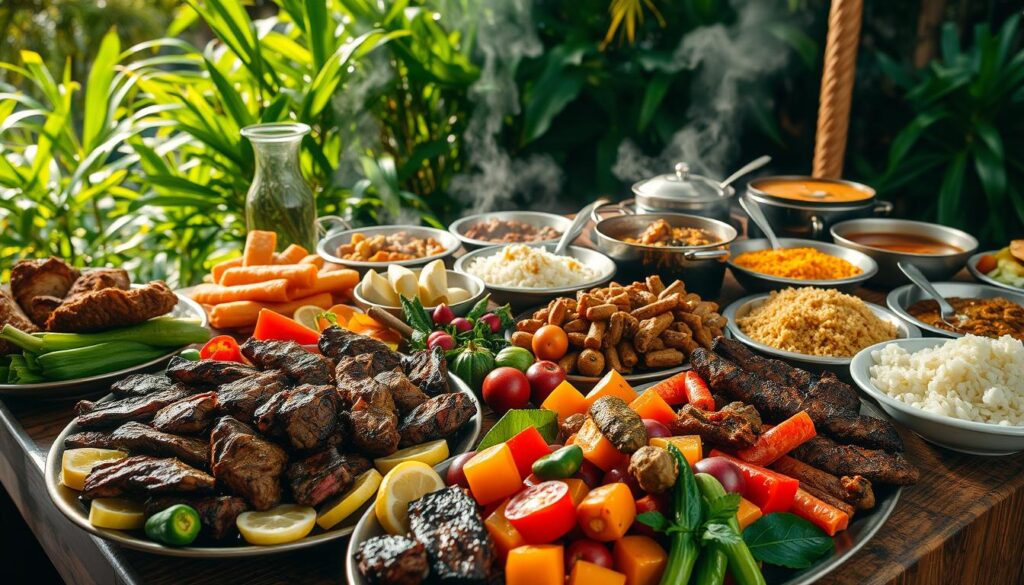
Signature Dishes You Must Try
Exploring Colombian cuisine reveals a treasure trove of signature dishes that define the country’s culinary landscape. Each dish tells a story of flavors, traditions, and cultural influences. You will encounter famous colombian recipes that showcase the rich ingredients and cooking techniques that make Colombian food distinctive and beloved.
Arepas: The Versatile Corn Cake
Arepas are a staple in Colombian households, appearing in countless variations across the nation. These versatile corn cakes can be grilled, baked, or fried and are often filled with cheeses, meats, or other delightful ingredients. Arepas con queso and arepas con huevo are popular choices that highlight the dish’s adaptability.
Sancocho: Hearty Meat Stew
Sancocho represents a beloved comfort food in Colombia, characterized by a rich combination of meats and root vegetables. Often featuring chicken, beef, or pork, this hearty soup includes plantain and cassava, making it a filling meal. Variations like sancocho de gallina are particularly favored in the Eje Cafetero region, stirring up warmth and nostalgia.
Bandeja Paisa: A Traditional Platter
Bandeja paisa stands as the national dish of Colombia, a grand assortment of ingredients served on one plate. This generous dish typically includes rice, beans, pork rinds, ground beef, sausage, a fried egg, black pudding, avocado, grilled plantain, and of course, an arepa. It’s a perfect representation of the country’s regional diversity and a must-try for anyone keen on famous colombian recipes.
Empanadas: Savory Pastries
Empanadas are delightful pastries filled with an array of ingredients like beef, pork, or chicken. Often enjoyed as a street food snack or a quick meal, they are commonly served with a tangy vinegary hot sauce. These savory bites encapsulate the heart of Colombian cooking and are a staple comfort food throughout the country.
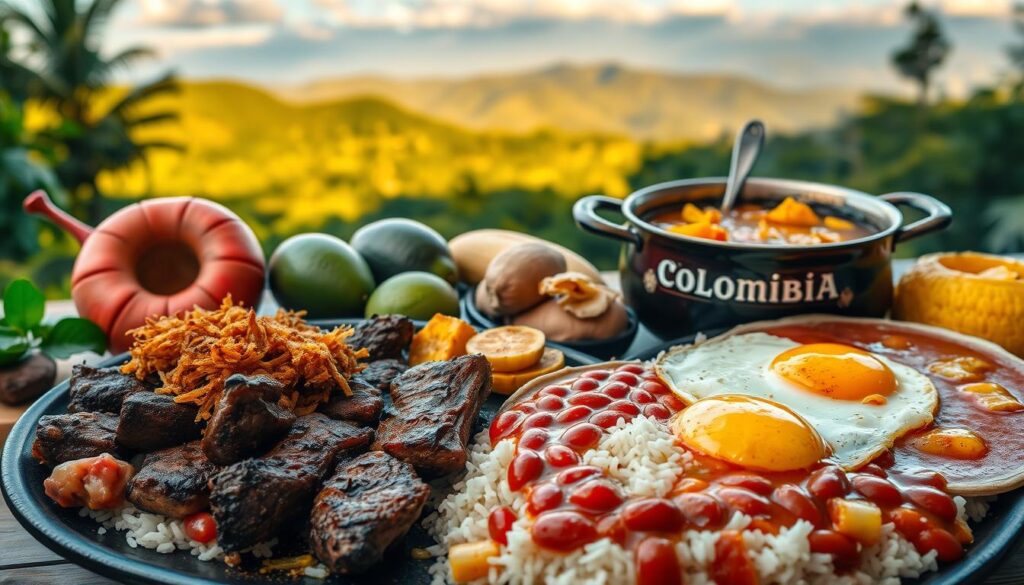
Discovering Regional Variations
Colombia’s rich diversity creates a culinary landscape vibrant with regional variations. Each area boasts distinct flavors, reflective of geographic features and cultural influences. Exploring these different styles of colombian food enhances your appreciation for the nation’s gastronomy.
Caribbean Colombian Cuisine
The Caribbean coast delivers a refreshing take on colombian food, spotlighting seafood and tropical fruits. Dishes are often lighter, celebrating flavors garnered from the sea and local bounty. Popular choices include:
- Fish prepared with coconut sauce
- Fried plantains
- Ceviche with lime and herbs
The Andean Influence
In the Andean region, tradition dictates a heartier style of cooking. This region’s altitude allows for the cultivation of potatoes and grains, integral to many meals. Signature dishes often include:
- Ajiaco, a diverse potato soup
- Bandeja Paisa, an iconic platter featuring multiple meats and sides
- Sancocho, a robust stew varying from chicken to beef depending on the area
Amazonian Delights
The Amazon region showcases unique ingredients, drawing from its lush rainforest surroundings. With access to exotic fruits and fish, regional specialties are distinct. Dishes such as:
- Casabe, a flatbread made from cassava
- Pirarucú, the world’s largest freshwater fish, prepared in various styles
- Salads featuring fresh, local produce
Each of these regional variations of colombian food highlights the diverse cultures and ingredients found throughout Colombia. The flavors and techniques reflect both tradition and the unique environment of each area, making culinary exploration an unforgettable experience.

| Region | Signature Ingredients | Typical Dishes |
|---|---|---|
| Caribbean | Seafood, tropical fruits | Ceviche, fried plantains |
| Andean | Potatoes, grains | Bandeja Paisa, Ajiaco, Sancocho |
| Amazon | Exotic fruits, freshwater fish | Casabe, Pirarucú dishes |
Key Ingredients in Colombian Cooking
Understanding the key ingredients in Colombian cooking reveals the heart of this vibrant culinary culture. The diverse offerings reflect Colombia’s rich agricultural heritage and regional distinctions, making them popular colombian ingredients that you’ll find in many traditional dishes.
Fresh Fruits and Vegetables
Colombia boasts an array of tropical fruits and vegetables, creating a colorful and flavorful experience. For instance, guava, recognized as Colombia’s most popular fruit ingredient, appears in pastries and snacks like bocadillo con queso. Avocados are also widely produced, with an annual yield exceeding 220,000 tonnes. They complement various dishes, especially the hearty bandeja paisa. Fresh fruit juices made from mango, pineapple, and passion fruit are commonly sold for just a couple of dollars, allowing everyone to experience the country’s vast fruit diversity.
The Importance of Corn
Corn plays a vital role in colombian culinary culture, serving as a base ingredient for staple foods. You can find it in forms like arepas, almojabanas, and bollos de mazorca, delightfully sold by street vendors across cities. Arepas in particular are enjoyed at all meals, highlighting their significance in daily life. This essential grain not only showcases Colombia’s indigenous roots but also adds heartiness and versatility to dishes.
Fragrant Spices and Herbs
The use of fragrant spices and herbs enhances the distinct flavors of Colombian dishes. Ingredients such as cilantro, cumin, and guascas are commonly used, making every bite savory and aromatic. Dishes like ajiaco soup leverage three types of potatoes and fresh herbs, delivering layers of flavors unique to Colombian cooking. Such ingredients underscore the importance of seasonings in bringing life to traditional recipes.
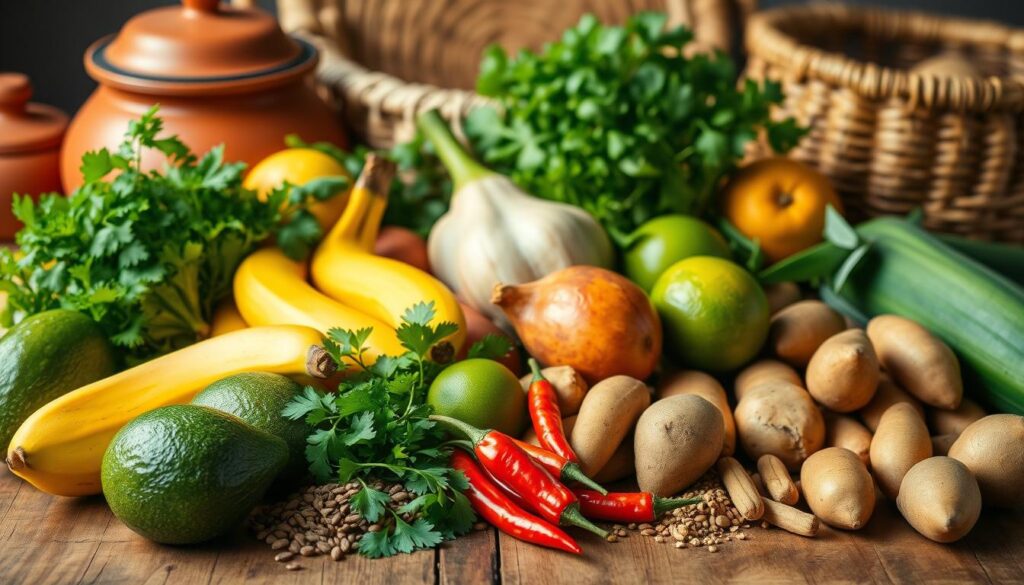
Typical Colombian Drinks
Colombia’s vibrant culture boasts an array of typical drinks that beautifully complement the country’s authentic colombian flavors. Visitors can experience a delightful range of beverages, from traditional spirits to refreshing concoctions. These colombian drinks embody the spirit of social gatherings and festive occasions, making them essential components of any culinary exploration.
Aguardiente: The National Spirit
Aguardiente stands as Colombia’s national spirit, beloved for its anise flavor. This drink holds significant cultural importance, especially in the Andean regions. A one-liter bottle of aguardiente costs around 40,000 COP ($14 USD). It is often enjoyed during celebrations, symbolizing camaraderie and festivity.
Coffee: A World-Famous Brew
Renowned worldwide, Colombian coffee is famed for its high quality and smoothness. Locals take pride in their brew, and you can find a tinto (a traditional black coffee) for as low as 700 COP ($0.25 USD). The richer, more refined americanos from trendy cafes can range up to 4,000 COP ($1.33 USD), offering various experiences for coffee lovers.
Limonada de Coco: Coconut Lemonade
Limonada de coco presents a refreshing twist, combining coconut and lemon flavors. Priced between 4,500 to 8,000 COP ($1.50-2.75 USD), this drink is perfect for hot days, providing a sweet yet tangy refreshment. It has become particularly popular in warmer climates, marking its rightful place among the favorite colombian drinks.

Street Food: A Culinary Adventure
Exploring street food in Colombia unveils a world of flavor and comfort that resonates with locals and visitors alike. This vibrant aspect of colombian food encapsulates the culture’s love for hearty, satisfying dishes often enjoyed on the go. Street vendors and food trucks play a significant role in making these delicious offerings accessible, showcasing a delightful range of options for all palates.
Fritanga: Grilled Meats and More
Fritanga stands out as a beloved staple among colombian food options. This enticing dish features an assortment of grilled meats garnished with a variety of sides. Typically found at street vendors, fritanga offers a fantastic way to sample different flavors and textures. Meat lovers especially appreciate the rich, smoky tastes that come from perfectly grilled selections, making it a must-try for anyone venturing into the street food scene.
Chocoramo: A Popular Snack
For those with a sweet tooth, chocoramo is an irresistible treat. This chocolate-covered cake provides a delightful burst of flavor, perfect for snacking between meals. Found at street stalls and convenience stores alike, chocoramo combines the richness of cake with the satisfaction of chocolate, making it a go-to choice for dessert enthusiasts exploring colombian food.
Salchipapa: A Comfort Food Favorite
One cannot overlook salchipapa, a classic comfort food that has captured the hearts of many. This dish features a mix of crispy French fries topped with sausage and drizzled in a variety of sauces. Salchipapa is not only delicious but also versatile, often accompanied by other toppings based on personal preference. It reflects the creativity and resourcefulness of colombian street food, appealing to families and individuals alike.
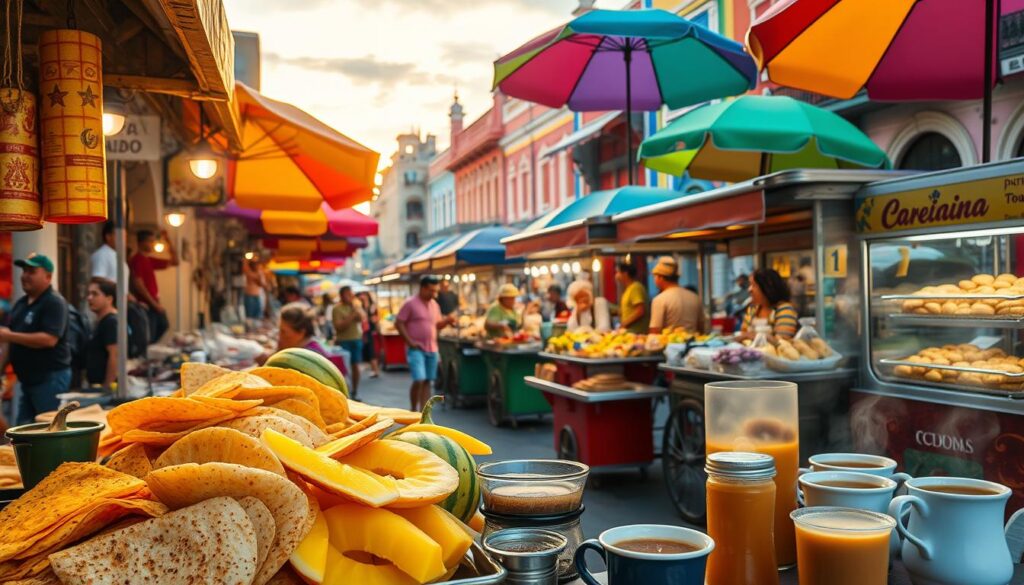
| Dish | Main Ingredients | Typical Serving Style |
|---|---|---|
| Fritanga | Grilled meats like pork, beef, and chicken | Served with sides such as potato, yuca, and avocado |
| Chocoramo | Chocolate, cake | Individually packaged, easy to grab on the go |
| Salchipapa | French fries, sausage, sauces | Typically plated or in a paper cone for convenience |
Traditional Colombian Desserts
Exploring traditional Colombian desserts offers a delightful glimpse into the country’s rich culinary heritage. Each dessert carries a unique flavor profile and cultural significance. Among the many treats, three stand out for their popularity and distinctive tastes.
Arequipe: Sweet Caramel Spread
Arequipe, similar to dulce de leche, is a cherished topping for many traditional Colombian desserts. This rich and creamy caramel spread is often paired with obleas or served alongside crackers, creating a perfect combination. Its sweetness enhances the flavor of various desserts, making it a staple in households across Colombia.
Natilla: Creamy Custard
Natilla is a creamy custard typically enjoyed during holiday seasons, especially Christmas. This dessert is delicately flavored with panela and cinnamon, giving it a warm and inviting taste. The smooth texture and delightful spices make natilla a favorite among families, symbolizing celebration and togetherness.
Buñuelos: Fried Cheese Balls
Buñuelos are beloved fried cheese balls, commonly prepared during festive occasions. Made from a mix of yuca flour, corn starch, and cheese, these traditional Colombian desserts are crispy on the outside and soft on the inside. While often enjoyed during Christmas, buñuelos can be found year-round, bringing joy to every gathering.

How to Enjoy Colombian Cuisine at Home
Bringing the vibrant flavors of Colombia into your kitchen can be an enjoyable endeavor. By incorporating simple tips and techniques, you can master the art of cooking Colombian dishes, allowing you to experience a taste of this rich cuisine at home. Sourcing fresh ingredients is essential, as this significantly impacts the authenticity of your meals.
Cooking Colombian Dishes: Tips and Tricks
When embarking on your culinary journey, consider the following tips:
- Utilize fresh ingredients to ensure flavors are bold and authentic.
- Experiment with spices like cinnamon and use panela for sweetening.
- Consider the regional variety, from coastal dishes with seafood to hearty soups typically found in the mountains.
- Practice traditional cooking methods, such as making arepas from masarepa.
Essential Colombian Cookbooks
To broaden your culinary repertoire, invest in essential cookbooks that feature famous Colombian recipes. These cookbooks provide step-by-step instructions for creating a wide array of traditional dishes, from comforting sancocho to sweet buñuelos. Some recommended titles include:
| Cookbook Title | Author | Description |
|---|---|---|
| Colombian Cooking: A Beginner’s Guide | Adriana T. Martinez | A comprehensive introduction to the basics of Colombian cuisine and its diverse regions. |
| Tastes of Colombia | Fernando A. Gonzalez | A collection of authentic recipes showcasing the best of Colombian everyday meals and festive dishes. |
| The Colombian Cookbook | Laura Balcazar | Focuses on traditional cooking techniques and celebrates the culinary heritage of Colombia. |

Eating Out: Finding Colombian Restaurants
Exploring Colombian cuisine in the U.S. opens a world of rich flavors and culture. The best colombian restaurants offer a unique dining experience, mixing traditional recipes with local ingredients. Customers find themselves savoring dishes like sancocho, bandeja paisa, and empanadas while enjoying the vibrant atmosphere that reflects Colombia’s diverse culinary heritage.
Top Colombian Restaurants in the U.S.
Among the best colombian restaurants across various states, you’ll discover standout establishments that prioritize fresh ingredients and authentic flavors. A popular choice is Ritchie’s Colombian Restaurant in College Park, Maryland, which opened in September 2022. This cozy spot was established by a couple who previously operated a bakery and wanted to share their love for Colombian home-cooked food with the local community.
| Restaurant | Google Rating | Price for Two | Operating Hours | Service Options |
|---|---|---|---|---|
| Ritchie’s Colombian Restaurant | 4.5 | $30 – $120 | 10 am – 1 am | No-contact delivery, Curbside Pickup, Dine-in, Takeout |
| La 27 Colombian Grill | 4.6 | $50 – $100 | 8 am – 7 pm | Dine-in, Takeout |
| El Mesón | 4.3 | $40 – $80 | 11 am – 11 pm | Curbside Pickup, Dine-in |
What to Order: A Guide for Newcomers
If you’re new to Colombian cuisine, navigating the menu can be an adventure. Recommended dishes to start with include:
- Sancocho: A hearty meat stew enriched with vegetables.
- Bandeja Paisa: A traditional platter showcasing various ingredients, perfect for sharing.
- Empanadas: Savory pastries, ideal as a snack or appetizer.
- Seafood Paella: A flavorful option reflecting coastal influences.
Understanding the significance of each dish not only enhances your experience but also connects you to Colombian culture. The best colombian restaurants ensure that you enjoy every bite while immersing yourself in this rich culinary landscape.
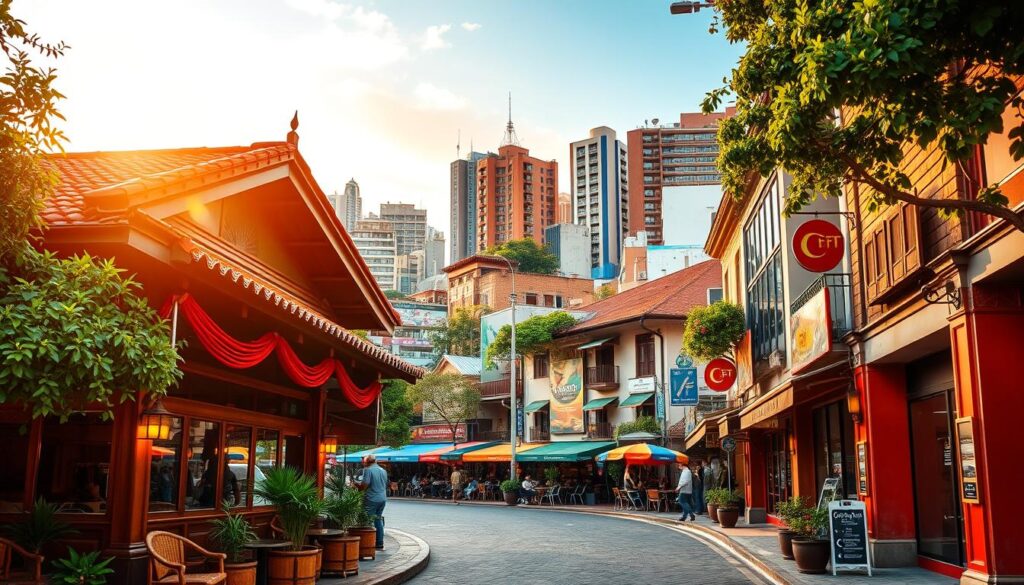
The Role of Colombian Cuisine in Celebrations
Colombian cuisine plays an integral part in cultural celebrations and family gatherings. Food is not merely sustenance in Colombian culinary culture; it represents a rich tapestry of traditions that strengthen family bonds and create lasting memories during special occasions. From annual festivities to everyday family meals, the joy of sharing food underscores the importance of these moments.
Traditional Festivities and Food
During major celebrations, specific dishes take center stage, offering a glimpse into the heart of Colombian culinary culture. Lechona, a delicious dish made from a whole pig stuffed with yellow peas and rice, is a popular choice during holidays. This grand dish symbolizes unity and is often the centerpiece at gatherings.
Other festive delights include tamales, which are commonly enjoyed during Christmas and New Year, showcasing the seasonal spirit. Traditional soups such as sancocho and ajiaco also align with local customs, providing comfort and warmth in celebratory settings.
Family Gatherings and Meals
Family gatherings emphasize the essence of togetherness in Colombian culture, with meals comprised of beloved dishes such as bandeja paisa. This hearty platter showcases a variety of proteins, including pork, beans, and plantains, embodying the country’s rich culinary diversity. The act of sharing food serves to connect with each other and celebrate heritage.
To complement these meals, there are vibrant options from the street food scene, including empanadas and patacones. These quick snacks, enjoyed at any time of day, exemplify the social aspect of Colombian food culture and create opportunities for families to bond during casual gatherings.
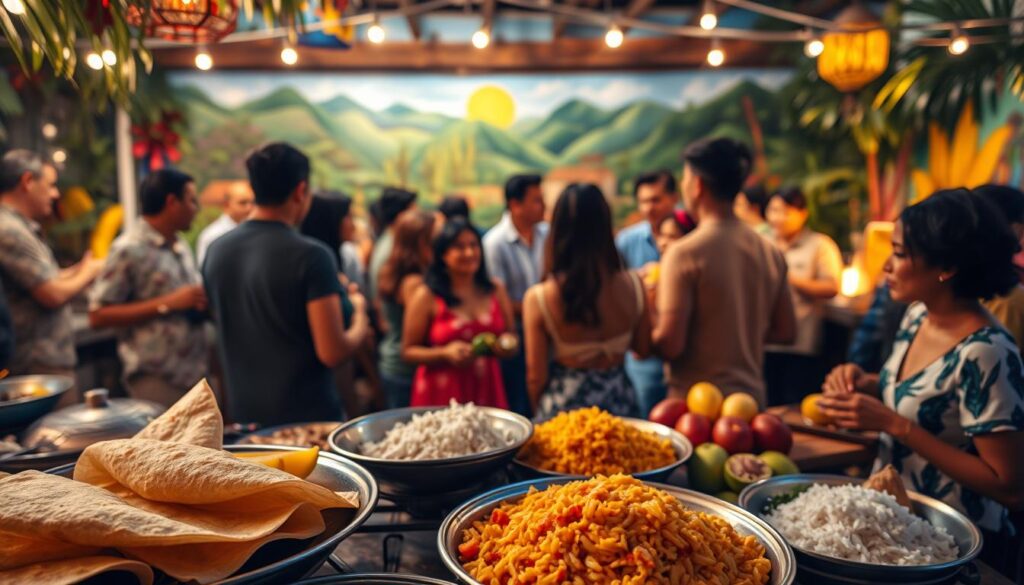
Pairing Colombian Food with Music
The culinary landscape of Colombian cuisine is deeply intertwined with its rich musical heritage. As you explore the delightful dishes, consider how traditional Colombian food pairs beautifully with the local rhythms and melodies. This connection not only enhances your dining experience but also immerses you in the vibrant culture that Colombia offers. Enjoying a meal accompanied by the sounds of cumbia or vallenato fills the air with a celebratory spirit, creating memorable moments that resonate in your heart.
The Connection Between Food and Culture
Colombian cuisine thrives on its diverse geographical influences and the fusion of indigenous, African, and European traditions. Meals are often occasions for communal gatherings, highlighting the role that sound plays in enhancing this shared experience. The energetic beats of Colombian music set a lively backdrop as dishes like bandeja paisa or sancocho take center stage, bringing together flavors and melodies in perfect harmony.
Colombian Music Styles to Know
Understanding the various musical styles prevalent in Colombia can enrich your appreciation of its culinary delights. Here are a few key genres to consider:
- Cumbia: A lively genre that originated from the African, indigenous, and Spanish cultures, perfect for accompanying festive gatherings and joyful meals.
- Vallenato: Known for its accordion-led melodies, this style enhances the warmth of Colombian cuisine, especially during family celebrations.
- Joropo: A traditional folk music style from the plains, often featuring harp and maracas, creating an upbeat atmosphere ideal for enjoying hearty dishes.
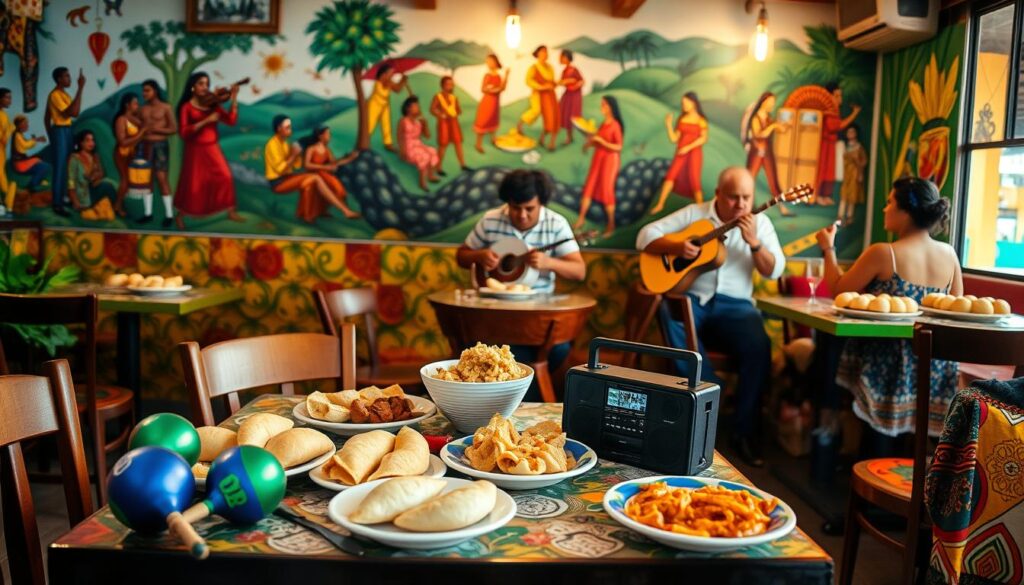
Incorporating these music styles as you savor dishes highlights the emotional connection people have with their food and culture. So, as you explore Colombian cuisine, consider curating a playlist that includes these vibrant rhythms, making each bite an experience that resonates on multiple levels.
Exploring Colombian Food Markets
Immersing yourself in Colombian food markets provides a unique opportunity to discover the rich tapestry of authentic ingredients that define the colombian culinary culture. These vibrant markets brim with fresh produce, spices, and regional specialties that enhance traditional dishes. Each market offers its own local flavor, reflecting the diverse culinary influences found throughout Colombia.
Where to Find Authentic Ingredients
Colombian cities such as Bogotá, Medellín, and Cartagena are home to bustling markets filled with unique offerings. In Bogotá, vendors sell a variety of potatoes, essential for dishes like ajiaco. Medellín is celebrated for its innovative food culture where exotic fruits such as lulo, maracuyá, and granadilla can be found. Cartagena’s markets specialize in seafood; ceviche, made from fresh raw fish marinated in citrus juices, stands out as a local favorite. Each region’s specialties reveal the depth of the colombian culinary culture.
Tips for Navigating Local Markets
To fully enjoy your experience in Colombian food markets, consider these helpful tips:
- Engage with Vendors: Don’t hesitate to ask questions about the ingredients. Many vendors are happy to share tips on cooking and using their products.
- Sample Before You Buy: Take advantage of tasting opportunities to ensure you enjoy the flavors before purchasing.
- Explore Seasonal Offerings: Different ingredients peak throughout the year, so be sure to try what’s in season for the freshest flavors.
- Be Open to New Experiences: You may find ingredients unique to each market. Trying something unfamiliar could lead to discovering new favorite dishes.

The Health Benefits of Colombian Ingredients
Colombian food provides an impressive array of ingredients that not only delight the palate but also offer numerous health benefits. Fresh fruits, vegetables, and wholesome grains are integral to the cuisine, enhancing its nutritional profile. Understanding the properties of these ingredients can help you make better choices while relishing the diverse flavors Colombian meals have to offer.
Nutritional Value of Common Dishes
Many Colombian dishes feature large portions, often appealing to those seeking ample protein intake. For instance, the famous Bandeja Paisa presents a fulfilling combination of red beans, white rice, ground meat, chorizo, fried egg, plantain, and avocado. This dish supplies significant nutrients, making it a favorite among locals and visitors alike.
Incorporating Colombian Foods into Your Diet
Incorporating Colombian foods into your daily meals introduces a variety of flavors and nutritional benefits. Colombian cuisine emphasizes the use of vibrant ingredients such as tropical fruits and vegetables, including avocados, tomatoes, and bananas. These foods offer valuable vitamins and antioxidants, supporting your overall health.
| Ingredient | Nutritional Benefits |
|---|---|
| Beans | Rich in fiber and protein; aids digestion and provides energy. |
| Fruits (e.g., Chontaduro) | Boosts immune system and offers vision improvement. |
| Fish (e.g., Ceviche) | High in omega-3 fatty acids; promotes heart health. |
| Maize | Source of carbohydrates for energy; combines well with proteins. |
| Cilantro | Rich in antioxidants; contributes to flavor without added calories. |
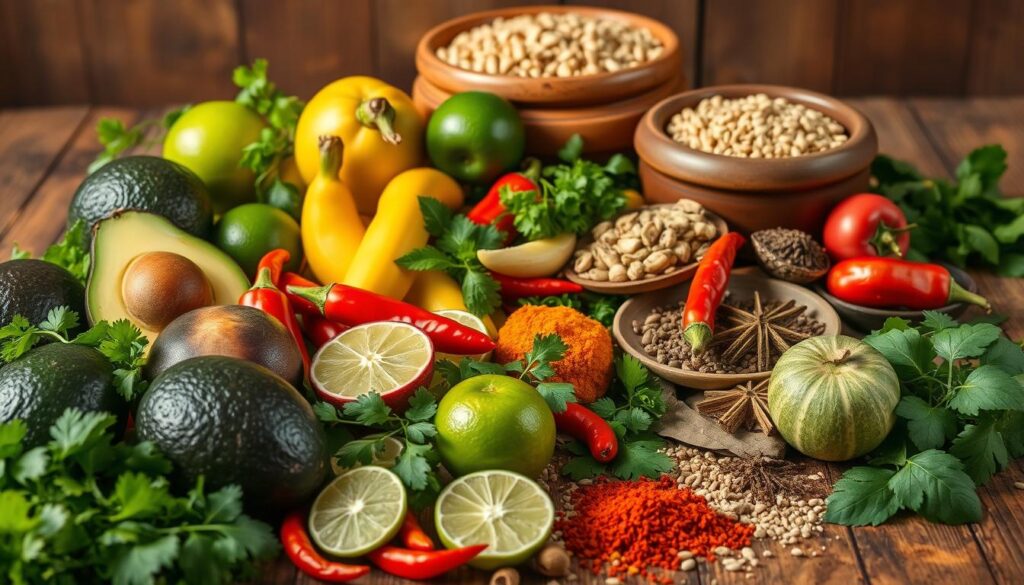
Cultural Significance of Colombian Meals
In the heart of colombian culinary culture lies the warmth of shared meals, where family becomes a central theme. Mealtime traditions highlight resilience and unity, as friends and families come together to enjoy the richness of their culinary heritage. These moments reflect not only nourishment but also the very essence of Colombian identity.
Meal Times: A Family Affair
Colombian meals are often a time for reconnecting with loved ones. Families gather, often indulging in dishes that resonate with local flavors, creating a nurturing environment. This shared experience fosters strong bonds and evokes a sense of belonging, making meal times an integral part of daily life. The tradition of asking “What did you eat today?” epitomizes the cultural importance of food in these gatherings.
The Ritual of Sharing Food
Sharing food is a cherished ritual in colombian culinary culture, transcending everyday dinners to include festive occasions. Dishes such as ajiaco or lechona are symbolic of celebration, inviting everyone to partake in the joy of cooking and eating together. This custom nurtures connections among community members, reinforcing ties and creating lasting memories around the table.
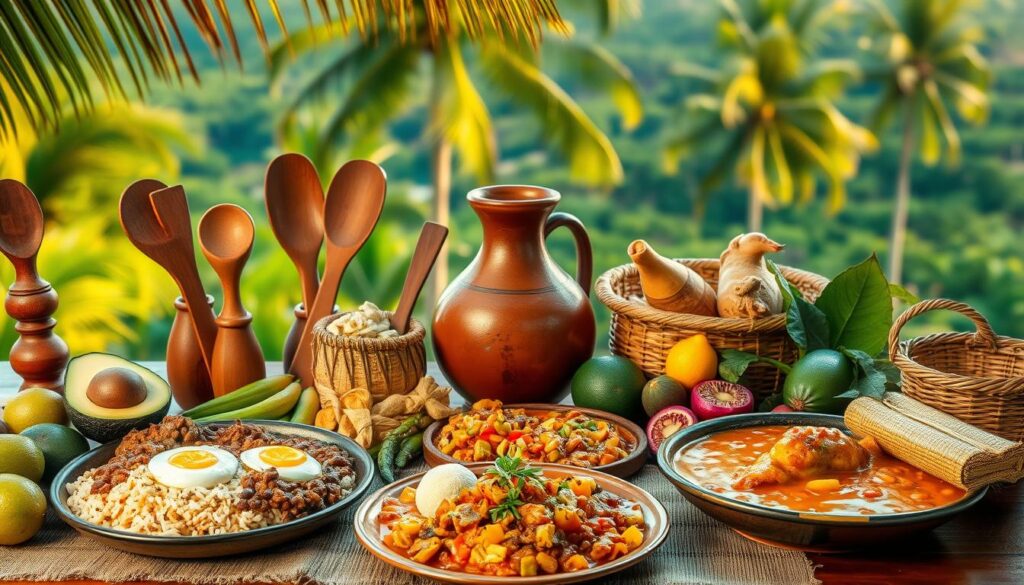
Embracing Colombian Culinary Heritage
Colombian culinary culture is rich with traditions that have been handed down through generations. Families share recipes that embody their unique history, flavors, and techniques. Each dish tells a story, offering a window into the lives and values of those who came before. By embracing this culinary heritage, you can connect to the heart of Colombian culture through the meals that bring people together.
Learning from Generations of Cooking
Learning from those who have shaped Colombian culinary culture allows you to appreciate the diversity and richness of its cuisine. Traditional recipes, like ajiaco and bandeja paisa, showcase locally sourced ingredients such as potatoes, corn, and beans, reflecting the land’s bounty. These recipes create not only a meal but also a connection to family gatherings and cultural celebrations, highlighting the importance of food in fostering a sense of community.
Preserving Traditional Recipes
Preserving traditional recipes requires a conscious effort to maintain the culinary identity of Colombia. Cooking methods, ingredient selections, and presentations play essential roles in this preservation. Dishes like arepas, ceviche, and plátano asado represent varied regional influences while remaining true to their roots. By passing down these culinary gems, future generations will be able to savor the authentic flavors of Colombian culinary culture.

| Dish | Main Ingredients | Significance |
|---|---|---|
| Ajiaco | Chicken, three potato varieties, corn | Celebration dish symbolizing unity |
| Bandeja Paisa | Ground beef, chorizo, fried eggs, arepas | Represents the diversity of Colombian food |
| Arepas | Corn flour, varied fillings | Staple side dish across all meals |
| Ceviche | Tomatoes, fish, lemon | Cultural variation showcasing local ingredients |
| Plátano Asado | Ripe plantains, cheese | Traditional appetizer highlighting local produce |
Conclusion: Savor the Diversity of Colombian Cuisine
Embracing the diversity of Colombian cuisine allows you to access a rich tapestry of flavors and traditions that reflect the country’s cultural landscape. From hearty dishes like Bandeja Paisa, which signifies abundance, to the warm comfort of Sancocho, each meal tells a story of heritage and community. Exploring these authentic Colombian flavors can heighten your culinary experiences, whether you are sampling dishes at local restaurants or trying your hand at home cooking.
Your Next Steps in Culinary Exploration
As you embark on your journey through Colombian cuisine, consider experimenting with recipes that use staple ingredients such as arepas or tamales. Visit a Colombian restaurant to gain first-hand experience of how these flavors are brought to life in a dining setting. Furthermore, engaging with online food communities can enhance your understanding and appreciation as you share recipes and tips with fellow food enthusiasts.
Join the Colombian Food Community
Joining the Colombian food community offers a platform to connect with like-minded individuals who cherish the authenticity of Colombian cuisine. By sharing your own cooking experiences and learning from others, you’ll deepen your appreciation for the country’s culinary heritage. Together, you can celebrate the vibrant flavors, enriching traditions, and the warm hospitality that are hallmarks of Colombian cooking.

